Mammals of the Adirondacks:
Eastern Coyote (Canis latrans var)
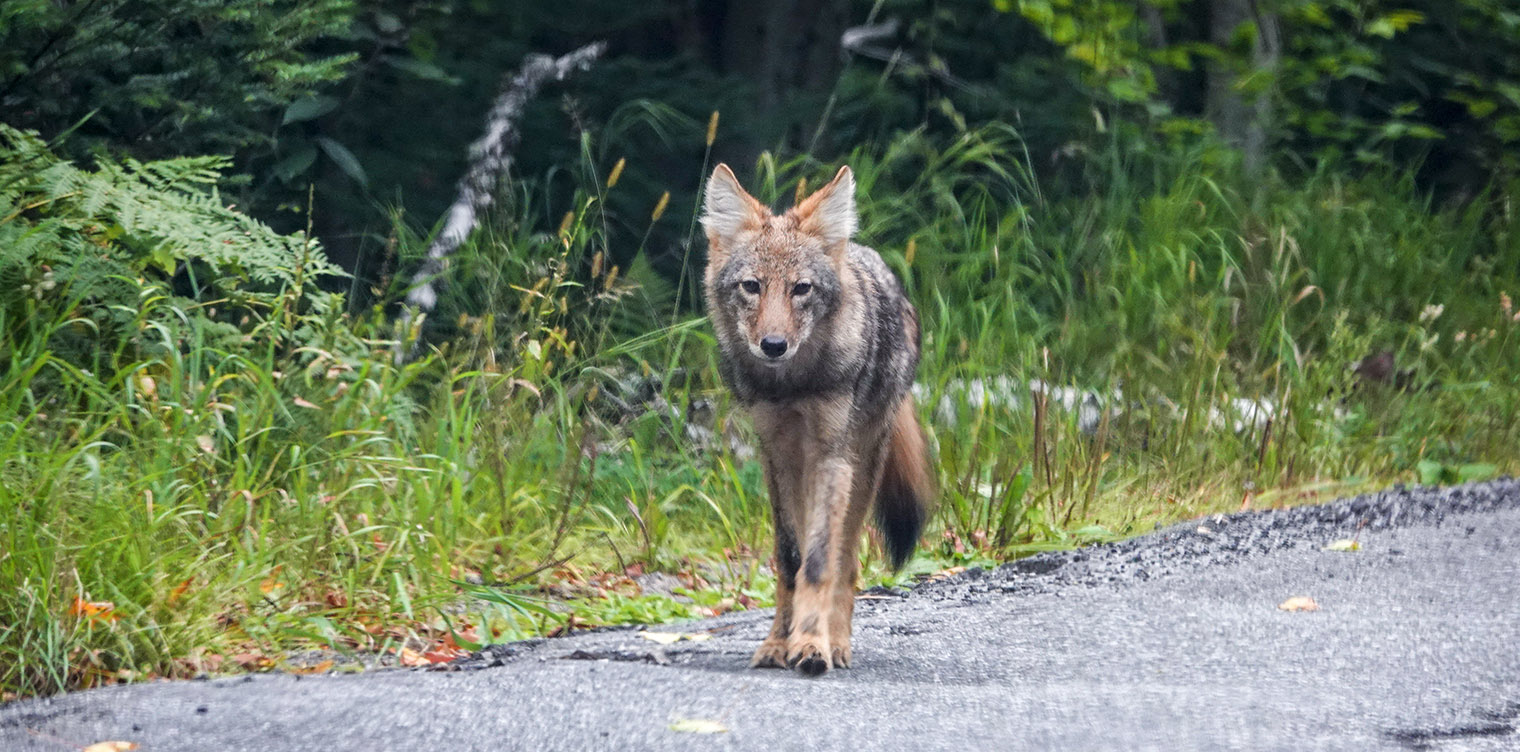
The Eastern Coyote (Canis latrans var), one of three canids that live in the Adirondacks, is an opportunistic predator at home in a wide variety of habitats. The name "coyote" is derived from the Aztec Indian word "coyotl." The scientific name (Canis latrans) is Latin for "barking (or howling) dog."
This animal has been the focus of a lively debate among canid specialists, who disagree on its taxonomy, social structure, diet, and ecological niche.
- Coyotes in the Northeast tend to be larger than their counterparts in the West, although sources disagree on how much larger.
- Coyotes in the Northeast are genetically more wolf-like in appearance and behavior than their counterparts in the West, although sources disagree on the relative contributions of coyote, wolf, and dog to this mammal's genome.
- Coyotes in the Northeast tend to be more reliant on larger prey (such as White-tailed Deer) than their counterparts in the West, although sources disagree on the relative contribution of large vs small prey in coyote diets, as well as the extent to which these mammals are moving into the ecological niche once held by wolves.
- Coyotes in the Northeast tend to show a greater tendency to hunt in extended family groups than their counterparts in the West, although sources disagree on the extent.
These disagreements have fueled an ongoing controversy on how to refer to this mammal and whether it is a separate species deserving of its own name.
- Some contend that the coyote of the Northeast (which is viewed as a hybrid between coyotes, wolves, and domestic dogs) should be recognized as a separate species, called the "Coywolf," with the scientific name of "Canis oriens."
- Other researchers acknowledge that this canid occupies a unique ecological niche and represents a hybridization between Coyotes, Gray Wolves, and domestic dogs, but oppose the creation of a new species, arguing instead that the names "Eastern Coyote" and "Canis latrans var" adequately capture the differences that set this animal apart from its counterparts out West.
- The Integrated Taxonomic Information System has thus far side-stepped the whole controversy, continuing to list this mammal as Coyote (Canis latrans), with 19 recognized subspecies.
The name adopted here to refer to coyotes residing in the Adirondack Park – Eastern Coyote (Canis latrans var) – reflects the name currently used by the New York State Department of Environmental Conservation.
Eastern Coyote: Description
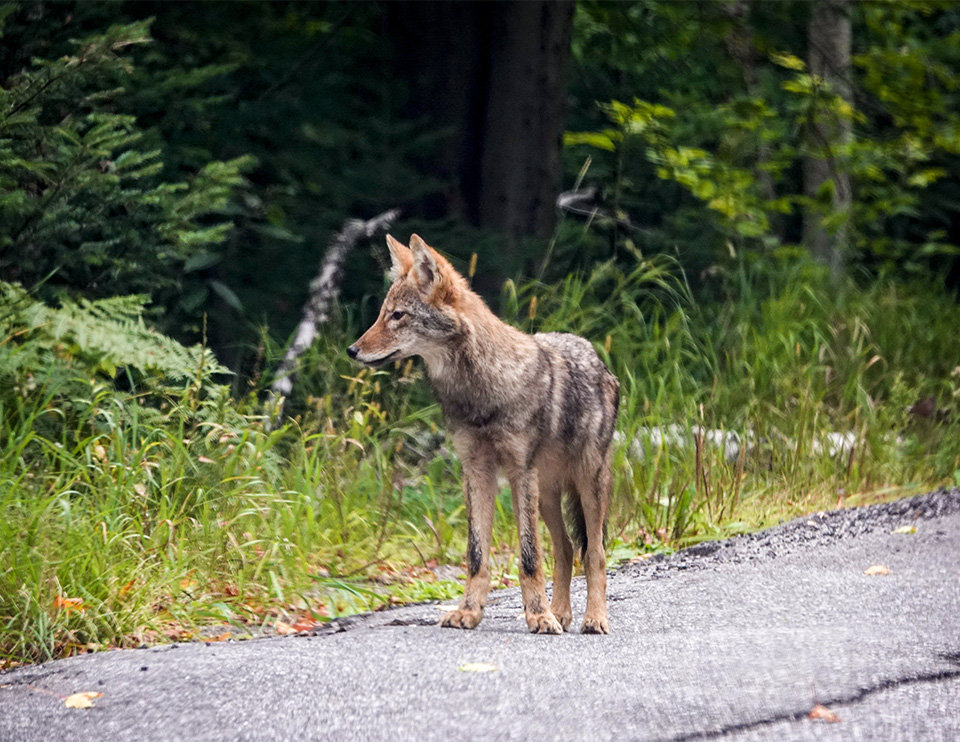
Eastern Coyotes are the largest wild canid in the Adirondack Park. They look something like a small German Shepherd Dog, with thick fur, bushy tails tipped with black, and large erect ears. Our Adirondack coyotes tend to be orange-gray or grayish brown above with paler underparts. The front surfaces of the lower legs are black, while the outsides of the legs are tan or rufous. The eyes are yellowish, with round pupils.
Sources conflict on the size of Eastern Coyotes. Some sources state their average weight as 20 to 35 pounds. Others suggest somewhat heavier weights (24 to 45 pounds or 32 to 36 pounds). These averages contrast with those of coyotes in the West, which are said to average 20-25 pounds. A few cases of Adirondack coyotes weighing 50-55 pounds have been recorded. There is some evidence that coyote body mass increases as one moves northward. In addition, the skulls of coyotes in the Northeast reportedly are larger and have craniodental characteristics similar to those of wolves.
Two possible (but not necessarily mutually exclusive) explanations for the weight difference between our Eastern Coyotes and coyotes living out West have been suggested.
- One possibility is that the larger body size of coyotes in the Northeast is a response to prey size and availability.
- Another possibility is that the larger size of coyotes in the northeast is due to hybridization with wolves and/or domestic dogs.
Sources disagree on the relative contributions of other canids to the coyote genome.
- Researchers spearheading efforts to give coyotes living in the East their own species stress the important of non-coyote genetic material, arguing that this mammal is about 60 percent coyote, 30 percent wolf, and 10 percent domestic dog.
- Canid specialists who oppose these efforts point out that the contribution of wolves varies. Coyotes in the Northeast show a mixture of 62% western coyote, 14% western wolves, 14% eastern wolves, and 11% domestic dog, while coyotes in Virginia average more dog than wolf (85%:2%:13% coyote:wolf:dog).
Eastern Coyote: Diet
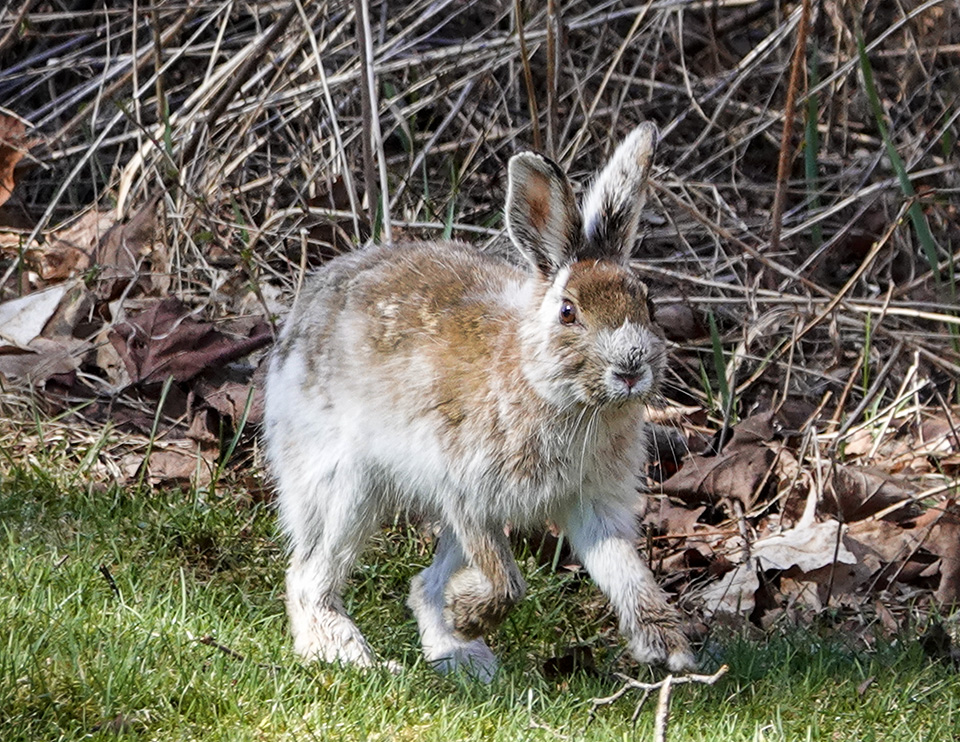
Although Eastern Coyotes are members of the order Carnivora, which encompasses a diverse group of mammals with teeth and claws adapted to catch and eat other animals, coyotes are omnivores. Like American Black Bears and Raccoons (two other members of the order Carnivora that live in the Adirondack Park), they are able to obtain nutrients from both plant and animal materials.
Eastern Coyotes have a diverse menu that varies throughout the year and includes both animal and plant materials. Prey items include White-tailed Deer (primarily fawns up to 20 days old), Snowshoe Hare, American Beaver, and birds. Healthy adult deer can and are successfully hunted by coyotes (hunting as a group), but most adult deer consumed by coyotes appear to be carrion or deer compromised by previous injury. Coyotes also prey on small mammals, such as rodents, but these play a lesser role for our coyotes than for coyotes in the West. Plant materials (particularly fruit) are important food items in the summer.
Studies of coyote foraging ecology in the Adirondack region indicate that coyote diets have shifted with prey availability.
- Analysis of coyote scats throughout the Adirondacks from 1956 to 1961 found that Snowshoe Hare dominated the coyote's winter diet, while Snowshoe Hare, White-tailed Deer, fruit, and insects shared the summer menu. Fruit and insects comprised nearly a third of the summer diet.
- A 1975-80 study of coyote scats collected near Newcomb in Essex County found that White-tailed Deer comprised the primary food in all seasons, followed by Snowshoe Hare. Small mammals were much less important (6.6% of the summer sample).
- A study of coyote scats conducted in the central Adirondacks from 1986 to 1989 also showed seasonal variability in coyote menus. White-tailed Deer played a much larger role, accounting for 82% of the volume of winter scats, 55% of the volume of spring scats, 45% of the volume of summer scats, and 18% of the volume of fall scats.
The most recent data, from a study of the foraging ecology of coyotes in the central Adirondacks, based on an analysis of coyote scats collected from 2009 to 2011, suggest a shift in Eastern Coyote menus in the Adirondack Park.
- The importance of White-tailed Deer had decreased. Although deer was still the most prevalent food item in both seasons, its occurrence in the diet declined to 42% of scats in the summer (vice 62-94% in previous studies) and 59% of scats in the winter (vice 89-94% in previous studies).
- The second and third most common mammalian prey species were American Beaver and Snowshoe Hare.
- Summer scats showed a more diverse diet, including fruits, beech nuts, and insects. Birds (primarily Wild Turkey) were found in 18% of the winter scats.
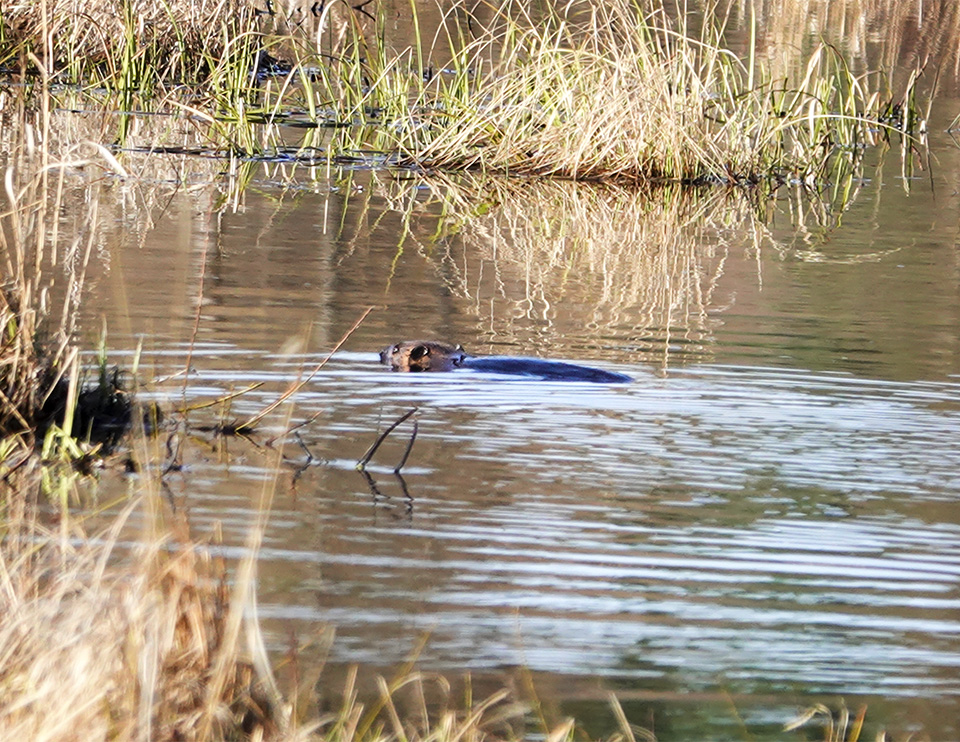
This shift in coyote diets in the Adirondacks appears to reflect changes in prey availability. According to this hypothesis, Snowshoe Hares and American Beavers constitute the coyote's primary prey items, while White-tailed Deer represent a secondary prey item.
- When coyotes first began to colonize the Adirondacks in the 1950s, beaver populations were low and Snowshoe Hare populations were declining, prompting coyotes to rely heavily on deer during this time.
- Beaver populations increased at a time when hare populations were continuing to decline, resulting in greater coyote use of beaver and lower reliance on deer.
- Coyote use of deer does not appear to be linked to deer abundance, since it was lowest at a time when the deer population was highest. Deer dominated coyote diets in the Adirondacks only when beaver and hare were both scarce.
If this hypothesis is correct, the Eastern Coyote is not a deer specialist and is not filling the ecological niche of the wolf.
Eastern Coyote: Reproduction and Family Life
Much of what is known about coyote reproduction and family life is based on studies of coyote populations outside of the Adirondack Park. This body of research indicates that coyotes are socially monogamous, although sources conflict as to whether the pair bond is for life. Courtship lasts about two to three months, with mating from January to March.
After a gestation period of about 63 days, females give birth in April or May to a litter of about six pups in an underground den, abandoned building, hollow log, or rocky crevice. Litter size depends on population density and food availability during the previous winter. Studies of litter size in northern areas suggest that litter size varies in response to Snowshoe Hare abundance.
Coyote young are tended by both parents and often other helpers, usually yearling coyotes from the previous year. Female coyotes stay close to the den site when raising pups, while males may travel greater distances in search of additional food.
Coyote pups are weaned when they are five to seven weeks of age and are fully grown at nine months. As the pups grow, they become more independent, but continue to move together as a family group, becoming more vocal in late summer and early fall. During that time, it is common to hear groups of coyotes howling and yipping.
Eastern Coyote: Behavior
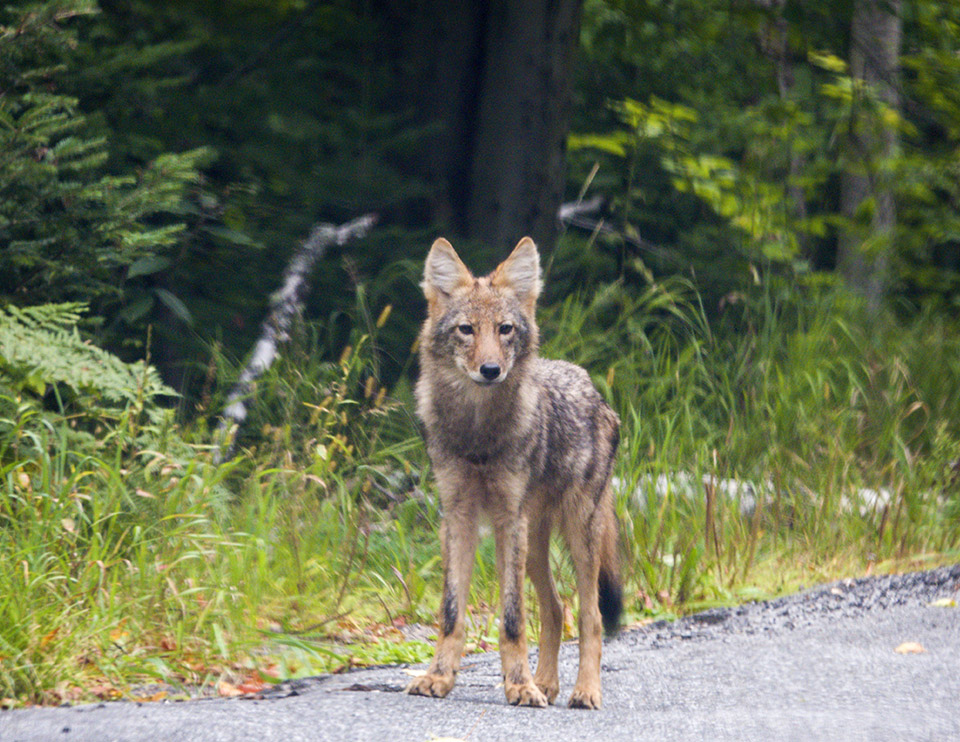
Coyote social organization and home range is highly variable, depending on habitat and prey size. Where the major prey items throughout the year are small rodents, coyotes tend to be solitary. In areas where large animals, such as elk and deer, are available, coyotes tend to form groups. Within these groups, coyotes are said to display a dominance hierarchy similar to that of wolves, although most canid specialists consider them to be less social than wolves.
Studies of Eastern Coyotes in the central Adirondacks suggest that our coyotes occupy large home ranges (7.5 square miles). They tend to travel and hunt in packs during the winter and as solitary individuals during summer. The pack structure allows exploitation of large prey, such as White-tailed Deer.
Coyotes communicate by scent-marking and group howling. They mark their territories by depositing scat and urine in prominent spots along trails. Coyote vocalizations include the growl, bark-howl, whine, yip, and yelp. The group howl, often starting with a series of yelps and ending with a series of short yaps, is apparently designed to signal territorial boundaries or to reunite the pack after a hunt.
Although group howling is most often heard at night, coyotes are active throughout the day as well, and it is not unusual to see coyotes in the daytime.
- A study of Eastern Coyote predation ecology in the central Adirondacks found that these animals averaged 24.4 kilometers of movement per day.
- The most active times occur at twilight and the first few hours of darkness.
- Recent studies of Eastern Coyotes who make their homes in suburban settings suggest that coyotes living in proximity to humans tend to limit their activity to nighttime.
In terms of tolerance for human disturbance, studies of Eastern Coyotes in the Adirondack Mountains suggest that our coyotes are fairly comfortable in human-modified environments. In contrast to Bobcats, which are least tolerant of humans, both Eastern Coyotes and Red Foxes show fairly high tolerance for human activities.
Eastern Coyote: Mortality and Predators
Although coyotes reportedly may live as long as 18 years in captivity, life expectancy in wild populations is shorter (apparently averaging about 14 years). The major source of mortality for Eastern Coyotes in the Adirondack Park is man. Hunting, trapping, and collisions with motor vehicles cause the vast majority of coyote deaths.
In New York State, the Eastern Coyote is one of ten species of furbearers than may be hunted or trapped.
- Hunters, who must purchase a hunting license, are allowed to kill coyotes at any hour of the day or night, from 1 October to 31 March. The only parts of New York State closed to coyote hunters are New York City and Long Island. Hunters can kill coyotes using a handgun, shotgun, rifle, bow, or crossbow. There is no limit to how many coyotes a hunter is allowed to kill.
- Trapping season for coyotes in northern New York State is from 25 October to 15 February. Trappers must have a license. There are no limits on the number of coyotes killed in this manner.
The New York State Department of Environmental Conservation did a survey of hunters covering the 2015-16 and 2017-18 hunting season. Survey results yielded an estimate of nearly 21,000 coyotes killed per season. The survey did not break down the numbers by region. The number of coyotes killed by trappers is not known.
Eastern Coyote: Distribution
Eastern Coyotes are relative newcomers to the Adirondack Park. The most widely-accepted theory for the coyote's colonization of our area is that this predator's presence here represents an expansion of the coyote's original range in central North America.
- According to this explanation, coyotes were once limited to midwestern prairies and the arid southwest.
- Coyotes were able to expand their range into the Adirondack Mountains after wolves were extirpated from heavily forested regions in New York State and other parts of the Northeast.
In any event, coyotes reached New York and the Northeast in the early thirties and forties, appearing first in Franklin County in the mid-twenties and spreading into pockets in Essex, Herkimer, and Oneida counties in the forties and fifties, traveling across Ontario, Canada, and entering northern New York by crossing the St. Lawrence River.
By the early seventies, the coyote had expanded its range to at least sixteen northern New York counties. By the 1980s, coyotes had become established throughout the state. These canids had by that time interbred with wolves and dogs, becoming somewhat larger, adopting some aspects of wolf social structure, and changing their foraging behavior to rely on larger prey.
The Eastern Coyote is now the most abundant large predator in the Adirondack Park. Estimates of coyote abundance and density in New York State vary.
- Studies conducted by researchers at SUNY College of Environmental Science and Forestry suggest that there are around 14,500 breeding pairs of coyotes in New York State during the summer. Estimates of coyote density based on call response indicate that the highest density of coyotes is found in the Adirondacks and Tug Hill region, with 2.5 pairs/10 square miles.
- Cornell University researchers found somewhat higher density in suburban landscapes, with coyote density estimated at 4.5 breeding pairs/10 square miles.
Eastern Coyote Habitat
Eastern Coyotes occupy a wide range of forest and field habitats. They are known to use the edges of second-growth forests, old fields, forest openings created by fire or logging, and urbanized areas.
Habitat use by Eastern Coyotes in the Adirondack Park has not been well-studied.
- A study of coyote foraging ecology in the central Adirondacks from 1986-89 found that coyote use of habitats varied with season. In winter, Eastern Coyotes favored habitats with dense under and mid-stories, as well as open habitats such as beaver meadows and frozen lakes.
- A 2008 study of the distribution and abundance of coyotes in the Adirondacks examined coyote presence using scat surveys. This study found that coyotes were most abundant in forest landscapes, particularly in disturbed forests with more open canopies found after logging and in natural edge habitats along wetlands and shorelines. Coyotes were less abundant in mature forests and areas of high human settlement.
The Coyote's Ecological Role in the Adirondacks
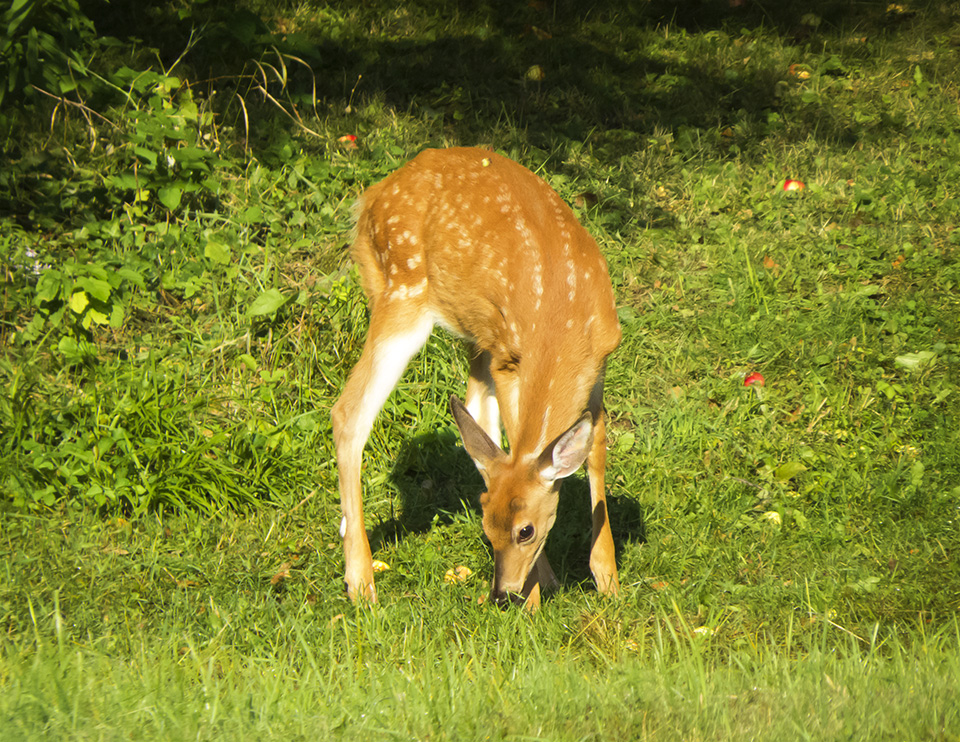
Scientists are still sorting out the ecological consequences of the coyote's range expansion. The future of the Eastern Coyote and its ecological niche in the Adirondack Park depends on developments affecting both their prey species (including White-tailed Deer, Snowshoe Hare, and American Beaver) and other mammals that prey on the same species (including Bobcat, Red Fox, and Gray Fox).
- Although White-tailed Deer represent a frequent prey item for Eastern Coyotes, especially in winter, recent research on the foraging ecology of coyotes in the central Adirondacks suggest that coyotes are not deer specialists and are not filling the ecological niche left by the extirpation of wolves. If this analysis is correct, coyote predation alone probably does not influence deer numbers significantly. Indeed, a recent study of the impact of coyote colonization on White-tailed Deer populations in six eastern states showed that coyotes are not controlling deer populations, with whitetail populations exerpiencing positive growth following coyote arrival.
- The Snowshoe Hare, another key prey item for Eastern Coyotes, is said to be experiencing a longterm population decline in New York State. This decline may be linked to climate change, which has changed the timing and duration of snow pack and decreased the hare's effectiveness at evading predation.
- Declining hare populations, coinciding with recovering American Beaver populations, may have been a factor underlying the Eastern Coyote's increased reliance on American Beaver. Beaver is now estimated to be the second most common prey item for coyotes in the central Adirondacks.
Developments affecting Eastern Coyote populations in the Adirondacks also have implications for predators that share their range: Red Fox, and Gray Fox and Bobcat.
- The diets of both Red Foxes and Gray Foxes overlap to some degree with those of Eastern Coyotes, who (according to some reports) do not tolerate their presence. One possible way for Red Foxes to coexist with an increasing population of coyotes is to move into human-dominated areas, since Red Foxes have a high tolerance for human presence.
- The Gray Fox, less tolerant of human activities, may be able to escape predation by coyotes through its ability to climb trees, giving them an advantage over Red Foxes and allowing them to occupy the same habitats as Eastern Coyotes.
- The impact of Eastern Coyotes on Bobcats is uncertain. Bobcats, which are also not well-tolerated by coyotes, share some of the same prey items. Unlike Eastern Coyotes, Red Foxes, and Gray Foxes, which supplement their diets with plant material (especially in summer and fall), Bobcats are obligate carnivores and almost entirely reliant on prey. Moreover, they are intolerant of human disturbance and unlikely to exploit human-dominated areas in reaction to competition from coyotes.
Adirondack Mammal List
References
New York State Department of Environmental Conservation. Eastern Coyote. Retrieved 16 February 2019.
Dan Bogan, "Rise of the Eastern Coyote," New York State Conservationist, Volume 68, Number 6 (June 2014), pp. 20-23. Retrieved 9 November 2019.
A.W. Bromley, "Re Adirondack Coyotes," New York State Conservationist, Volume 10, Number 4 (February-March 1956), pp. 8-9. Retrieved 9 November 2019.
Robert E. Chambers, Peter Gaskin, Roger A. Post, and Stuart Cameron, "The Coyote," New York State Conservationist, Volume 29, Number 2 (October-November 1974), pp. 5-7. Retrieved 9 November 2019.
C.W. Severinghaus, "The Coyote Moves East," New York State Conservationist, Volume 29, Number 2 (October-November 1974), pp. 8, 36. Retrieved 9 November 2019.
William Hamilton, "Food Habits of the Coyote in the Adirondacks," New York Fish and Game Journal, Volume 21, Number 2 (July 1974), pp. 177-181. Retrieved 9 November 2019.
C . W. Severinghaus, "Notes on the History of Wild Canids in New York," New York Fish and Game Journal, Volume 21, Number 2 (July 1974), pp. 117-125. Retrieved 9 November 2019.
New York State Department of Environmental Conservation. Small Game Hunting. Retrieved 4 February 2019.
New York State Department of Environmental Conservation. Furbearer Hunting. Retrieved 4 February 2019.
New York State Department of Environmental Conservation. Coyote Hunting Seasons. Retrieved 16 February 2019.
David Figura. DEC survey: What animals are most popular among New York's small game hunters? Retrieved 28 January 2019.
New York State Department of Environmental Conservation. The Status and Impact of Eastern Coyotes in Northern New York (Bureau of Wildlife, June 1991). Retrieved 19 March 2017.State University of New York. College of Environmental Science and Forestry. Coyote. Retrieved 28 March 2017.
Gary Brundige. Predation Ecology of the Eastern Coyote (Canis latrans var.) in the Central Adirondacks, New York. Ph.D. Dissertation, State University of New York, College of Environmental Science and Forestry, Syracuse, 1993. Abstract. Retrieved 10 February 2019.
Julie L. Tesky. Canis latrans in Fire Effects Information System (FEIS). Species Reviews. Forest Service, Rocky Mountain Research Station, Fire Sciences Laboratory (United States Department of Agriculture, 1995). Retrieved 20 January 2019.
Marc Bekoff, “Canis Latrans,” Mammalian Species, Number 79 (15 June 1977), pp. 1-9. Retrieved 29 March 2017.
Integrated Taxonomic Information System On-line Database. Canis latrans. Retrieved 22 February 2019.
University of Michigan. Animal Diversity Web. Coyote. Canis latrans. Retrieved 22 February 2019.
D. Andrew Saunders. Adirondack Mammals (Adirondack Wildlife Program. State University of New York. College of Environmental Science and Forestry, 1988 ), pp. 147-151.
William K. Chapman. Mammals of the Adirondacks. A Field Guide (North Country Books, 1991), pp. 89-91, Plate 14.
John O. Whitaker, Jr. and William J. Hamilton, Jr. Mammals of the Eastern United States (Cornell University Press, 1998), pp. 393-403.
William J. Hamilton and John O. Whitaker, Jr. Mammals of the Eastern United States. Second Edition (Cornell University Press, 1979), pp. 260-264. Retrieved 9 February 2019.
iNaturalist. Adirondack Park Sightings. Coyote. Canis Latrans. Retrieved 30 May 2021.
Alexander C. Martin, Herbert S. Zim, and Arnold L. Nelson. American Wildlife & Plants. A Guide to Wildlife Food Habits (Dover Publications, 1951), pp. 227-228. Retrieved 14 February 2019.
James M. Ryan. Adirondack Wildlife. A Field Guide (University of New Hampshire Press, 2008), pp. 210-211.
Donald W. Stokes and Lillian Q. Stokes. A Guide to Animal Tracking and Behavior (Little, Brown and Company, 1986), pp. 266-275.
William Henry Burt. A Field Guide to the Mammals of North America North of Mexico. Third Edition (Houghton Mifflin Company, 1980), pp. 69-70, Plate 7.
National Geographic Society. Wild Animals of North America (National Geographic Society, 1995), pp. 220-222.
Adrian Forsyth. Mammals of North America. Temperate and Arctic Regions. (Firefly Books, 1999), pp. 169-170.
Richard M. DeGraaf and Mariko Yamasaki. New England Wildlife: Habitat, Natural History, and Distribution (University Press of New England, 2001), pp. 318-319, 327-328, 330-331, 340-343, 347-352, 356-357, 420, 454. Retrieved 11 February 2019.
Marc Bekoff and Eric M. Gese, "Coyote. Canis latrans," in George A. Feldhamer, Bruce C. Thompson, and Joseph A. Chapman (Eds). Wild Mammals of North America: Biology, Management, and Conservation. Second Edition (The Johns Hopkins University Press, 2003) pp.467-481.
Cornell Lab of Ornithology, Ithaca, New York. Birds of North America. Subscription Web Site. Eastern Whip-poor-will; Eastern Phoebe; Ruffed Grouse; Mallard; Spruce Grouse; Wild Turkey; and American Black Duck. Retrieved 24 February 2019.
Scott A. Warsen. Evolving Niche Of Coyotes In The Adirondack Mountains of New York: Long-Term Dietary Trends and Interspecific Competition. A thesis submitted in partial fulfillment of the requirements for the Master of Science Degree State University of New York, College of Environmental Science and Forestry (Syracuse, New York. May 2012). Retrieved 18 January 2019.
Northeastern States Research Cooperative. Adirondack Study Exposes Evolving Niche of the Coyote in Northeastern Forests. Retrieved 19 January 2019.
Jacqueline Frair and Mark Teece. Evolving Niche of the "Coy-wolf" in Northeastern Forests and Implications for Biodiversity. Undated. Retrieved 19 January 2019.
Jacqueline Frair, James Gibbs, Gordon Batcheller, and Paul Jensen. Population Status and Foraging Ecology of Eastern Coyotes in New York State (2014). Retrieved 10 January 2019.
Jacqueline Frair. Top Dog? Exploring the Ecological Role of Coyotes in NY. Northeastern States Research Cooperative Webinar. 11 November 2015. Retrieved 22 February 2019.
Project Coyote. Coyote Ecology. Retrieved 23 February 2019.
Dana Kobilinsky, " Wolves and Coyotes Play Different Ecosystem Roles," The Wildlife Society. 21 March 2017. Retrieved 19 January 2019.
John F. Benson, Karen M. Loveless, Linda Y. Rutledge, Brent R. Patterson, "Ungulate Predation and Ecological Roles of Wolves and Coyotes in Eastern North America," Ecological Applications, Volume 27, Number 3 (April 2017), pp. 718-733. Abstract. Retrieved 23 March 2019.
James W. Hody and Roland Kays, "Mapping the Expansion of Coyotes (Canis latrans) Across North and Central America," ZooKeys, 759: 81-97. 22 May 2018. Retrieved 19 January 2019.
Eugenia V. Bragina, Roland Kays, Allison Hody, Christopher E. Moorman, Christopher S. Deperno, and L. Scott Mills, "Effects on White‐tailed Deer Following Eastern Coyote Colonization," The Journal of Wildlife Management, 20 March 2019. Retrieved 22 March 2019.
Roland Kays, Abigail Curtis, and Jeremy J. Kirchman,"Rapid Adaptive Evolution of Northeastern Coyotes via Hybridization with Wolves," Biology Letters, Volume 6, Issue 1 (29 July 2009), pp. 89-93. Retrieved 23 March 2019.
Josée-Anne Otis, Dan Thornton, Linda Rutledge, and Dennis L. Murray, "Ecological Niche Differentiation Across a Wolf-coyote Hybrid Zone in Eastern North America," Diversity and Distributions, Volume 23 (2017), pp. 529-539. Retrieved 18 February 2019.
Maggie Bordas, Niche Alteration and Range Expansion of the Eastern Coyote (Canis latrans): An Examination of Predator Ecology. 2016. Retrieved 19 February 2019.
Roland Kays, "Yes, Eastern Coyotes Are Hybrids, But the ‘Coywolf’ Is Not a Thing," The Conservation, 13 November 2015. Retrieved 19 February 2019.
Jonathan G. Way, "Why the Eastern Coyote Should be a Separate Species: The ‘Coywolf’," The Conversation, 11 May 2016. Retrieved 18 February 2019.
Jonathan G. Way " Taxonomic Implications of Morphological and Genetic Differences in Northeastern Coyotes (Coywolves) (Canis latrans × C. lycaon), Western Coyotes (C. latrans), and Eastern Wolves (C. lycaon or C. lupus lycaon)," The Canadian Field-Naturalist, Volume 127, Number 1 (January–March 2013), pp. 1-16. Retrieved 19 February 2019.
Jonathan G. Way and William S. Lynn, "Northeastern Coyote/coywolf Taxonomy and Admixture: A Meta-analysis," Canid Biology & Conservation, Volume 19, Number 1 (2016), pp. 1-7. Retrieved 19 February 2019.
J. Monzón, R. Kays and D. E. Dykhuizen," Assessment of Coyote–wolf–dog Admixture Using Ancestry-informative Diagnostic SNPs," Molecular Ecology, Volume 23, Number 1 (January 2014), pp. 182-197. Retrieved 22 February 2019.
Robert E. Chambers, "Diets of Adirondack Coyotes and Red Foxes," Transactions of the Northeast Section, the Wildlife Society, Volume 44 (1987), p. 90.
Javier Monzón. Rapid Evolution of Northeastern Coyotes. A Dissertation Presented in Partial Fulfillment of the Requirements for the Degree of Doctor of Philosophy in Ecology and Evolution, Stony Brook University. December 2012. Retrieved 8 February 2019.
Matthew E. Gompper. The Ecology of Northeast Coyotes: Current Knowledge and Priorities for Future Research. WCS Working Paper Number 17 (July 2002). Retrieved 10 February 2019.
Cecilia A. Hennessy, Jean Dubach, and Stanley D. Gehrt, "Long-term Pair Bonding and Genetic Evidence for Monogamy Among Urban Coyotes (Canis latrans)," Journal of Mammalogy, Volume 93, Issue 3 (28 June 2012),pp. 732–742. Retrieved 5 March 2019.
Paul D. Curtis, Daniel A. Bogan, and Gordon Batcheller, "Suburban Coyote Management And Research Needs: A Northeast Perspective," Wildlife Damage Management Conferences – Proceedings. Paper 80. Retrieved 5 March 2019.
Dietland Muller-Schwarze. The Beaver: Its Life and Impact. Second Edition (Cornell University Press, 2011), pp. 124-127.
Kelly F. Robinson, Duane R. Diefenbach, Angela K. Fuller, Jeremy E. Hurst And Christopher S. Rosenberry, " Can Managers Compensate for Coyote Predation of White-Tailed Deer?" The Journal of Wildlife Management, Volume 78, Number 4 (May 2014), pp. 571-579. Retrieved 10 February 2019.
Joanne M. Thurber and Rolf O. Peterson, "Changes in Body Size Associated with Range Expansion in the Coyote (Canis latrans)," Journal of Mammalogy, Volume 72, Number. 4 (November, 1991), pp. 750-755. Retrieved 23 February 2019.
Heather M. Fener, Joshua R. Ginsberg, Eric W. Sanderson, And Matthew E. Gompper, "Chronology of Range Expansion of the Coyote, Canis latrans, in New York," The Canadian Field-Naturalist, Volume 119, Number 1 (January–March 2005), pp. 1-5. Retrieved 11 February 2019.
Tyler J. Wheeldon and Brent R. Patterson, "Comment on “Northeastern Coyote/coywolf” Taxonomy and Admixture," Canid Biology & Conservation, Volume 20 (2017), pp. 14-15. Retrieved 10 January 2019.
Lauren L Mastro, Eric M. Gese, Julie K. Young, and John A. Shivik. Coyote (Canis latrans), 100+ Years in the East: A Literature Review" Addendum to the Proceedings of the 14th Wildlife Damage Management Conference (2012). Retrieved 23 February 2019.
Roland W. Kays, Matthew E. Gompper and Justina C. Ray, "Landscape Ecology of Eastern Coyotes Based on Large-Scale Estimates of Abundance," Ecological Applications, Volume 18, Number 4 (June 2008), pp. 1014-1027. Retrieved 10 February 2019.
